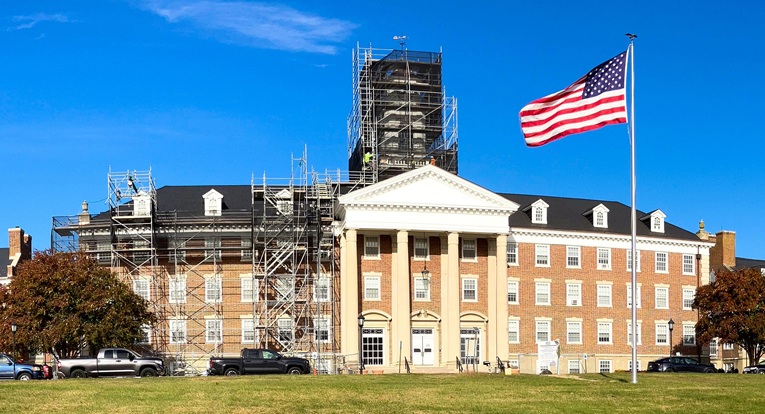At the Greenbelt City Council worksession on August 6, a draft of a staff letter to be included in the city’s final budget book as well as in response to a Government Finance Officers Association (GFOA) requirement was presented to council by City Manager Josué Salmerón. It specifies two possible five-year financial scenarios. Both acknowledge real estate taxes as being the city’s highest income source, with all income sources increased by 1 to 6 percent. Yet, in the first scenario, the city’s expenditures for the nine city departments were increased, while those in the second scenario were lowered. Some of the factors assessed were: the cost of the new police union contract and the cost of the standard salary, as affected by cost-of-living and merit increases, and inflation.
A draft letter from council to residents was examined as well. It is a recap of the newly adopted Fiscal Year (FY) 2026 budget. It states that the budget is $40.1M, with an increase of 5.6 percent from the FY 2025 budget, with no increase in the property tax rate. Some of the highlights were maintaining of core city services; the continued funding and implementing of projects through use of $22.88M in American Rescue Plan Act funds; a new four-year union agreement with the police department; drafting the Vision Zero Plan, which hopes to curtail traffic injuries and deaths; expanding EV infrastructure throughout the city; enhancing the city’s revenue opportunities, including looking into ways to fully cover waste collection and refuse costs; and the possible creation of a city circulator bus service with an established route (to ride the existing Greenbelt Connection bus one must call in advance to arrange for pickup).
Both letters are currently being further developed by staff for later presentation to council.
It was noted by all that the potential redevelopment of Beltway Plaza, with its addition of housing units and recreation space, will possibly require an increase in police and recreation staff.
Salmerón stated that work needs to be done to bring in more business and industry to the city. Investment in incubators and office parks was suggested.
Advisory Boards
There was a lengthy discussion on the city’s advisory boards and committees, specifically around appointments, reappointments and attendance. This was a follow-up to the meeting on June 9 when feedback from these groups was gathered in an effort to increase the efficiency of these entities. Councilmember Danielle McKinney offered a comprehensive summation of the ideas and recommendations examined at this meeting.
Concerning eligibility and terms of service, it was posited that board members submit a new statement of intent when their term of service has come to an end, and that board and committee chairs be given the chance to weigh in on a reappointment to ensure that the member has performed their duties responsibly.
A possible central tracking system for attendance was put forth. Attendance in general was an important topic, as it is essential to the proper workings of these boards. It was acknowledged that there were instances where lack of attendance should be excused due to unexpected life situations.
The application process was examined, with some of the major recommendations being greater detail requested on the forms; the creation of a more efficient and clear process on application submission and review by staff and council; and, the important and encouraged step of an applicant attending a board meeting prior to the council interview.
With regard to reappointments, some of the recommendations were a 60-day prior notice by the city clerk to board members nearing the end of their term and a review by board chairs of reappointments 30 days before the end of term.
Some refinements to the application form and interview questions sought to gather deeper insight into an applicant’s intent, relevant experience and their thoughts on how a board could better serve the city.
It was noted that vacancies on boards can be infrequent, often resulting in applicants having to wait months, if not years, for an opportunity to serve. Salmerón offered the idea of a 60-day update to applicants.
All stated that there needs to be greater transparency concerning the application process and expectations for service on these boards in order to increase recruitment. The recommendations discussed will be brought before council in a future meeting for possible codification.
Tracking Petitions & Requests
Mayor Emmett Jordan felt that it was important that any petitions and requests to the city be properly recorded and tracked as to their status. McKinney said that there is such a record on the city’s SharePoint site. Councilmember Kristen Weaver said that there is paid software available that can enhance a city’s ability to log and track these queries. Council decided to create a sign-in list for petitions at meetings to more efficiently present them.
Stakeholder Meetings
Jordan stated his desire to better reach out to the city’s stakeholders, noting that in some cases, years have transpired between meetings. He was keen on meeting with Greenbelt Homes, Inc. and the city’s HOAs. He added that some of these stakeholders do not wish for a face-to-face meeting.
Concerning the disagreement over the meeting with the Maryland-National Capital Park and Planning Commission at the August 4 meeting (see the August 21 issue), council reiterated its wish to be given advance notice of such requests in order to participate if desired.



